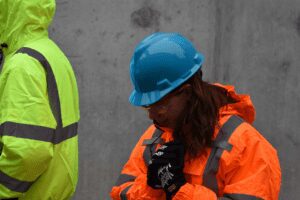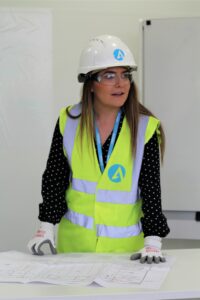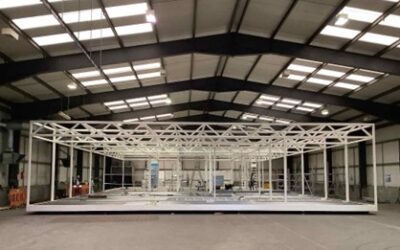Ardmac is working hard to encourage more women
into Engineering and Construction
Ardmac Director of Engineering Michael Quinn considers how a stronger focus on culture, representation, confidence and opportunity can encourage more women into careers in construction and engineering
As part of their guidelines for the 2018 employment policies of the Member States, the council of the European Union determined that all Union members should work to ensure gender equality and increased labour market participation by women.
CSO figures indicate that the construction industry in Ireland currently has the highest number of women working in the industry on record, with the figure increasing by 25% in 2021 to a total of 14,400. Despite this, women still only make up approximately 9% of the overall construction workforce in the country.
The figures specific to Women in STEM in Ireland make for slightly better reading, with the CSO reporting 25% of jobs that require STEM skills are currently occupied by women. However, with only 1 in every 6 engineering graduates being female the likelihood is that the figure for Women in Construction related STEM roles is much lower.
Given the career opportunities available, the impact made by the industry worldwide and the innovation happening on an ongoing basis, this no longer makes sense.
Along with current global supply chain issues, the shortage of personnel is seen as the greatest challenge facing the construction industry in Ireland. Over the coming years, this is likely to be the single biggest barrier to achieving Government targets for house building, the current National Development Plan and continuing to support the growth of multi-national companies in Ireland.
Over the past 20 years, I have seen the construction industry undergo significant advancement in terms of health and safety, digitalisation, and the application of technology with a ‘work-smarter-not-harder’ philosophy being adopted. At Ardmac, we “Work Smart”, meaning we deploy innovative technology throughout our business to empower our people, drive performance and delight our customers. To support this advancement, the types of roles within the construction industry have had to evolve with multiple new technology-based roles emerging and the level of physically demanding roles reducing.

Over 70% of construction firms are said to fully recognise the need for more women in the industry. It is also clear that there is a huge shortage in construction personnel and that there are more diverse and well-paid roles available within the industry. Despite all this, the uptake of construction sector roles by women remains low. A significant amount of good work has been undertaken over the past few years by organisations such as the CIF and Engineers Ireland to promote the industry as inclusive and diverse, but the sector still remains one of the most gender-segregated in the world.
The reason for this appears to be down to the perception of the industry that still exists. As part of a 2018 survey carried out by the CIF for their #BuildingEquality campaign it was suggested that the Construction Industry had an image problem. One of the comments received relating to this was as follows:
“I think many women when they think of the construction industry think or hard hats, cold weather, dirty building sites and a lot of physical labour. Add to that a perception that it is male oriented, and you can see why it may not be viewed as an attractive career for a woman.” (Senior female professional)
As part of Engineer’s Ireland STEPS programme for Engineering Week, I recently gave a presentation to approximately 100 female transition year students on engineering as a career. When I asked the group what their impression of the construction industry and engineering as a career was, much of the initial feedback I received was in line with the above quote. Whilst us within the industry know that careers in construction have changed considerably, becoming more flexible, more technology driven, safer and less physically demanding, there is still much work to do in getting this message across to the wider population.

All roles within the construction industry should be and need to be open to women
The key is ensuring that this message is clearly communicated and that the actions of the industry demonstrate this to be true. We need to ensure recruitment campaigns are described and advertised in such a way as to attract a diverse group of applicants.
We need to ensure young women have the same opportunity and exposure to careers in the sector.
From a young age, men see family members, contacts and connections working in the industry. It has been socially acceptable in society for generations for men to see construction as a viable long-term career. They also benefit from being offered subjects at school which provide insights into the work involved and building confidence in their abilities to do the work and find it rewarding. Career offices promote engineering to young men, meaning key elements of the funnel channelling young men into the industry exist as standard. We need to do the same for young women.</P
We need to normalise STEM careers for men and women starting at primary school.
This includes representation, experience of the work, understanding the impact of the work and training /experience of the type of work involved. We need to continue to work with careers offices within schools to promote the opportunities available and put forward the women and men of our industry who have forged successful careers.
We need to promote the value and impact of the construction industry
We need to make sure we are conveying the right message to women in promoting these roles. The industry needs to focus on recruitment campaigns that present the vision of the industry and its impact on people and their quality of life. Communicating the contribution that construction projects make to people’s lives and the challenging and fulfilling roles available in the industry will help to attract the right calibre of people. Employees at Ardmac are lucky to experience this on an on-going basis as we contribute to the delivery of exciting and innovative projects in the life sciences sector, from mobile micro-vaccine production facilities to large scale drug manufacturing facilities. A career in the construction industry can take you all over the world and present you with the opportunity to be involved in hugely rewarding projects where, regardless of demographics, you can make a significant contribution to the project and society itself.




